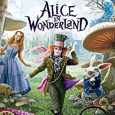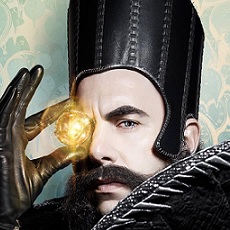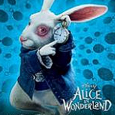Disney Brothers/Winkler Pictures (1925-1927), Inkwell Images (2007), single TDK Durabis-branded DVD-R, 64 mins plus supplements, 1.33:1 original full frame ratio, Dolby Digital 2.0, Not Rated, Retail: $26.95
Storyboard:
Walt Disney’s first star wasn’t even animated but she sure enjoyed a whole heap of adventures in a cartoon wonderland! This unique collection features ten examples of some of Walt’s earliest work.
The Sweatbox Review:
Once again thanks must go out to Ray Pointer, who continues his crusade in bringing ultra-rare pre-Golden Age vintage cartoons from private collectors’ assortments to the wider DVD capable animation enthusiast. Following Pointer’s own Inkwell Images compilation of Disney’s earliest films, The Laugh-O-Gram Fairy Tales, this program immediately picks up on what Walt did next. The Alice Comedies found Walt finding his feet in Hollywood. The Laugh-O-Grams had served a purpose: to train young Walt and his eager crew in the basic terms of making animated cartoons, though what really shines in those early films is Disney’s already strong attention to story and how those techniques gain more authority during the series’ short run.
Sadly, Walt’s business sense wasn’t as strong and a deal he’d made to distribute the films fell through, meaning a lack of exposure and a lack of funds. A couple of commissioned shorts saw him able to stave off hunger and gave him enough to produce one last hope in 1923, a combination live-action/cartoon film that reversed the then popular Out Of The Inkwell series. Where the Fleischers popped their Ko-Ko The Clown out into our real world, Walt would send his actress Alice into a cartoon one, almost 40 years before Julie Andrews and Dick Van Dyke would do the same in Mary Poppins!
The first “pilot” film, Alice’s Wonderland (touched on but not included here), set up the routine, showing how Alice (a young Mary Pickford-esque Virginia Davis) visits the cartoon studio and later dreams of entering the animated world as she sleeps. The self-funded film was enough to land the fledgling Disney Studio a deal, and a series – Walt’s first and the one that established him in Hollywood – was born. Alice’s Wonderland was first made more widely available for the first time in years in the supplements of the mid-1990s deluxe LaserDisc edition of Walt’s 1951 feature Alice In Wonderland, even though the plots have little to nothing in common.
Though the ending fragments of the film had been thought to have been lost to time, a handful of the rest of the 56 Alice Comedies themselves have since come to DVD in various incarnations, most notably in an “official” release as part of the Walt Disney Treasures title, Disney Rarities. That set contained seven examples, including the pilot that restored the original ending, and came accompanied by jolly jazz band music scores. The presentation was, as expected, pretty slick, from fairly solid prints only marred by some minor interlacing issues. Inkwell Images released a previous collection, Alice In Cartoonland, in 2000. This 60-minute compilation of seven films offered up a brief documentary introduction with a narrated potted history of the series, taking in the four Alices: Davis (from the 1923 pilot and 1924-25 series), Anne Shirley (1925), Margie Gay (1925-26) and Lois Hardwick (1927), and fair 16mm print transfers mostly from the later Raytone sound re-issues, with the soundtracks painstakingly located and restored.
More recently, Kit Parker Films put out a collection of 13 films through the VCI label, responsible for generally decent compilations of Max Fleischer material. This edition, Alice In Cartoon Land By Walt Disney released in 2007, duplicated some titles from both the Inkwell and Disney releases, though the packaging claimed them to have been transferred from original 35mm nitrate negatives, again from the Raytone re-issues. Pointer’s answer is a new version of his original Alice In Cartoonland, a Revised Edition in his Golden Classics line. Now running to 80 minutes, this 2007 compendium reorganises the original line up, adds a couple of shorts and better transfers of others, and packs in much more of the polished, illuminating documentary material, now interspersed between the cartoons.
Opening with a re-edited and re-voiced version of the original 2000 prologue, it’s clear that this new Inkwell collection finds the company producing as glossy a product as anyone out there. The quality on the re-edited opening immediately suggests a more rounded and professional result and the picking of a female narrator (Wendy Mogul) this time around adds a unique charm to what is all too often a similar sounding male voice on such programs. Newly inserted is an introduction to Margaret Winkler, the distributor who picked up the Alice Comedies series from Walt, which combines some attractive graphics, stills, and a vintage sounding soundtrack. Some information might need a fact-check: I’m pretty sure Alice In The Jungle wasn’t the second Alice film, though it did contain footage from Alice Hunting In Africa, which was an early short that wasn’t released until later in the run.
We begin with this cartoon, Alice In The Jungle, from 1925, which finds Alice and her faithful cat Julius on safari. A popular cartoon by all accounts, this actually isn’t one of the better examples though it appears on all the previous Alice releases. In actual fact, although the film features Davis, it was completed long after she’d left the series, being a reworking of the Africa short that hadn’t pleased Winkler, who ordered the live-action be re-used with new animation. Alice herself only sporadically features (the mid-to-later shorts often only featured Alice in set ups and payoffs, leaving the bulk of the action to be handled by Julius), with the short mostly a series of jungle gags. Animals come and go (one good sequence has two elephants bathing with plenty of gags) and the main thrust is essentially Julius’ fight with a gang of lions, but the cartoon does end with an intriguing thought: an elephant that can fly by flapping its ears! Now that’s an idea!
Dawn O’Day replaces Davis for one time only, in 1925’s Alice’s Egg Plant, made while Walt was re-negotiating the salary demands of Virginia Davis’ mother. Although O’Day only lasted one outing (what Walt could pay her wasn’t enough to sustain her family’s needs), Alice’s Egg Plant is easily one of the best of the Alice Comedies. Walt had already starting digging into satirical humor with the Laugh-O-Grams, but here the threat of the 1920s “Red Scare” is spoofed (in this uncut version) with the name of the Little Red Henski, a communist rooster who causes trouble in the chicken coop by demanding “shorter hours” and “smaller eggs”. There’s some delicious word play too (“Another hen party!”) and some sneaking capitalism from Alice, who fixes her egg shortage problem by charging the hens one egg each to watch two roosters duking it out! O’Day would later change her name to Anne Shirley and become a minor Hollywood sensation in movies such as Anne Of Green Gables (which inspired her name change), Stella Dallas opposite Barbara Stanwyck, and the classic The Devil And Daniel Webster. With a good story structure, and a fun ending that features a transparent switch from the live Alice to an animated one, Alice’s Egg Plant is still a great cartoon today.
With negotiations to bring Davis back on board eventually failing, Walt found his next and longest-serving Alice in Margie Gay, who had appeared in another one-off Alice Comedy prior to O’Day’s appearance. The idea was to update the look to a 1920s flapper type, a “mini-Louise Brooks” as the commentary has it, and Walt recalled the young actress who had stood in for Virginia Davis in Alice Solves The Puzzle. Gay was brought back and starred in the series for most of the rest of the run, only being replaced by Lois Hardwick for the final handful of shorts as the series began to concentrate on their animated sequences more and more.
Alice Solves The Puzzle is the next cartoon here, and it’s another good one, not so much in its “plot” but in the technical tricks that Walt and his crew are obviously playing with and slowly perfecting. There’s a lot of trick photography here that allows Alice to interact with her cartoon counterparts, including some ingenious switches to all-animation for some super diving displays with Julius, and even some early physical interaction that still looks impressive. More importantly, though going unmentioned, is that this short features the first appearance by a character that would shape himself into Pegleg Pete – actually Disney’s oldest character to have survived into the present day (though his introductory “Bootleg Pete” gag was snipped from the re-issues and remains lost today).
Alice Is Stage Struck, shown here under its re-issue title Alice Gets Stage Struck, from 1925, is certainly a product of its time, with a staging of a live-action production of Uncle Tom’s Cabin going well until our heroine is knocked unconscious and she dreams of being swept along the ice with Pete in pursuit. Really good here are the child actors, especially the oily villain, trading on his James Finlayson looks. A stronger, if basic, story helps motor this forward, and once again there are some great gags (“I’ll make you eat those words!”) that play on the silent format, and the evidence in the artists’ confidence with more elaborate chase scenarios and perspective backgrounds is impressive. Though this rare 35mm print comes from the AFI’s Library Of Congress collection, it appears to be missing a few shots from the closing sequence, but it’s not enough to distract and the fade out joke still works well enough.
The next couple of shorts follow the same lines. Alice Wins The Derby (1925) has a title that gives away the ending, just in case you thought there was a chance Alice wouldn’t win any derby she entered. Here she’s competing with Julius as they ride an auto-horse race against bad ol’ Pete, who as usual uses every trick in the book – yes, including a detour! – to cheat to win. The animation here really is fluid, and though it concentrates on Julius, there are still some “how did they do that?” moments with Alice that may be all too clearly obvious to our special effects trained eyes today, but still come over well enough to momentarily astonish.
Alice Rattled By Rats again dispenses with Alice herself (rather quickly it must be said) and leaves Julius in charge of the house, where he must try to maintain quiet when a group of jazz lovin’, party poppin’ rats gatecrash. It is perhaps fun to see some historical inspiration for Remy and the Ratatouille rats’ kitchen escapades, but this is product of its time, the Prohibition jazz age, and there’s nothing particularly remarkable about this one, and many of its basic scenes will be familiar to those with the second Mickey Mouse In Black And White collection, where the short When The Cat’s Away plays as an almost shot-for-shot remake. Alice’s Orphan (1926) again focuses on Julius, when he finds an abandoned kitty and takes it home to Alice. It’s progressively elaborate once more, featuring good snow and fire effects animation, and this print apparently has a restored sequence, although there’s no denoting the actual instance and I couldn’t make out a discernible difference between the different editions’ cuts.
The collection concludes with an example of Alice #4, Lois Hardwick, a professional child actress who saw out the last handful of cartoons. Though the Alice Comedies had started running out of steam long before the end of the series, Alice The Whaler, from 1927’s last batch of ten Hardwick Alices (it was her eighth appearance) is actually pretty fun, with plenty of Alice herself and lots of characters, even if they are dancing in cycles. Hardwick herself seems to be having fun, and there are laughs from a playful monkey and a parrot that forecasts a similar bird in Steamboat Willie a year later. In fact there’s quite a bit here that predates Mickey’s own boating trip, including a little potato peeling ship rodent (half Mouse-half Oswald Rabbit) himself who finds himself bullied by a Pete-a-like. The cartoon ends oddly once Alice actually has a whale in her sights, but it’s otherwise a better than average series entry to end on.
The Alice Comedies series is an important milestone in Disney history as it was these films that allowed Walt to make his mark in Hollywood – the only cartoon producer to do so while the competition was all still New York based. From the proceeds, he was able to build the fabled Hyperion Avenue studio, which brother Roy suggested be re-named The Walt Disney Studio, and land a further deal with Universal to produce cartoons featuring their star Oswald The Lucky Rabbit. Although wranglings over the future of the Oswald series would later prove a major blow to Walt, it was this adversity that led him to resolve to never work for another employer again, and Mickey Mouse’s debut in 1928 remained the opening of the floodgates that let Snow White, Pinocchio, Fantasia and all those wonderful cartoons and feature flow.
So when the often repeated sentiment “It all started with a Mouse” is uttered once more, remember that it really began before that, with a Rabbit, and before that with a little girl named Alice. In recent times, Disney’s Oswald has seen a return to the fold by way of some opportune corporate dealings and we shall soon be seeing those adventures in their own celebratory collection. But Disney’s legacy begins with the Laugh-O-Grams and right here, with these vastly entertaining, surprisingly plot-driven shorts. Inkwell’s “Revised Golden Edition” provides a context and a choice selection of which to enjoy them.
Is This Thing Loaded?
As with other Inkwell Images releases, the total running length of the disc includes what I would refer to as the bonus material itself: the documentary segments that provide the essential behind the scenes history behind the cartoons. In addition to these moments, which I have commented on above, this new Alice In Cartoonland also provides us a couple of two additional bonus cartoons, holdovers from the previous edition which I suspect have been labelled as such since they don’t quite meet the strict image or audio requirements to have made it into the newly remastered “main feature” compilation. They run together for a close-to 16 minute total.
Alice The Toreador is an earlier 1925 Virginia Davis effort, with more of a starring role for Alice before she became sidelined in favor of Julius, who it is said Walt wanted to bring centerstage to feature in the next series of cartoons. Since cartoon cats were almost two-a-penny, Julius was swapped for Oswald the Rabbit, much to Walt’s later detriment. Although the cat plays a major role here, it’s still Alice’s show, and Davis shows how good she was, for an inexperienced child actress, at interacting with characters that would only be added later. Pointer seems to have sourced this one from a VHS copy, adding his own soundtrack using vintage recordings for a genuine feel and sometimes too obviously new spot sound effects. Alice On The Farm (also 1925 though it was released early 1926) returns to the re-issue tracks of the Raytone releases, and hardly features Margie Gay’s Alice until Pegleg Pete pops up for an attempted kidnap. Naturally, Julius is on the case and he uses his Felix-like tail as a sword in an epic duel to the finish, winning back a grateful Alice. The print does indeed come from a new film transfer rather than a previous tape copy, though it’s easily the most worn of any in this collection. However, its inclusion as an extra rather than being dropped entirely from the disc is most welcome.
Alice’s Gallery, advertised as a DVD-ROM feature, is actually a two-minute video montage of nine Alice Comedy theatrical posters (from other entries in the series – only Alice In The Jungle is represented on the disc), but since the cover specifically promotes the posters as a DVD-ROM gallery, I couldn’t help but check the disc’s contents anyway, and sure enough, buried in an Adobe document labelled Alice PDF, are eight (Alice’s Fishy Story goes missing) of the same promotional images! I wouldn’t say these are of printable quality, but they do allow for closer inspection than the standard DVD definition allows, and this is a new feature to Ray’s Inkwell discs that I hope he develops to a greater potential in future!
A one-minute Inkwell Animation Anthologies Promo for other titles in the line prompts one to check out Before Walt, Max Fleischer’s Famous Out Of The Inkwell: Bonus 2-Disc Edition, George Herriman’s Kinomatic Krazy Kat Kartoon Klassics, Max Fleischer’s Ko-Ko Song Car-tunes, Mutt And Jeff: The Original Animated Odd Couple and this Alice disc. One thing to watch out for is the modernly recorded main menu music, which is several notches higher in volume than the majority of the cartoons and could surprise one when jumping back and forth!
Case Study:
Interestingly, all the releases use a variant of the original Alice publicity posters, with little Virginia Davis helping Julius The Cat up onto a giraffe for Alice In The Jungle. This appears to be a popular image, appearing in most Alice references in books as well, including the superb Walt In Wonderland, an encyclopaedic review of Disney’s silent film career from the Laugh-O-Grams to early Mickey, which is referenced here. The packaging of this new 2007 edition is more elaborate than the 2000 original, with some fancy bordering and color shading adding a vintage feel to the simple stark blackness from the first edition. A simplified version of the text on the back of the sleeve fixes at least one typo but adds a spelling error to an actress’ name, while also listing the included cartoons and bonuses. While I felt the main title treatment could have been bolder, it’s an attractive sleeve with a pleasingly mottled purple background effect that feels suitable “aged”. The disc art improves on the 2000 release too, with a nice golden tone that plays up the rich “Golden Classics” angle.
Ink And Paint:
When dealing with vintage film – of any kind – from the era we are discussing here, there has to be a leniency in what kind of image quality one is to expect – in many cases, we’re lucky to have some of these titles still available to us at all! The image quality here is, on the whole then, exceptionally good in most places, with only a couple of shorts suffering from any issues, and even then of the minor kind expected in archival material. Fairly, Alice The Toreador and Alice On The Farm have been placed in a bonus section, but mostly these prints and transfers build on the already solid work seen in the first incarnation of the program. My only complaint would be some color flecking I noticed on some composite video shots which could have been desaturated to illuminate this occurrence. I also noted some horizontal line issues on the graphical elements, which again I would put down to interlaced material being flagged as progressive. Especially good, though, are Alice’s Egg Plant and the 35mm example Alice Gets Stage Struck, but most of the cartoons here are unbelievably steady (Alice The Whaler even seems to use the same print as the Disney edition, evident from the framing and unfortunate print marks). I’d have perhaps liked to see some brightness boosting, though understand that it can be a tricky proposition to handle correctly (Alice The Whaler, for example, is terribly over exposed on VCI’s collection. It eliminates any print damage, yes, but at the expense of bleaching out valid animators’ lines). This Inkwell edition remains more evenly consistent throughout.
Scratch Tracks:
Once again, the Raytone re-issue soundtracks come into handy play here, and I have to say that I don’t have any problem with them at all. Added quickly and cheaply to the series so that they could be sent out again to cash in on the Disney name, Walt had nothing to do with them whatsoever, and while some have labelled them as irritating or crass, they at least come from the same era and not long after the films’ original release. The tracks sound “authentic” in that their appealingly crackly sound matches the print-worn look of the visuals, and Pointer’s reconstructions have again been matched wonderfully to provide a level of entertainment value that would be missing with a general organ accompaniment or contemporarily recorded music (a complaint I actually had with the sometimes heavy-handed Disney release). Nicely done, providing a way for purists to watch as intended (they can turn the sound off!) and for audiences of today.
Final Cut:
In all fairness, completists will want to think about purchasing both Inkwell’s current edition and the VCI disc, if only for the additional cartoons found between them. Though I probably prefer the “authentic” sounding re-issue tracks over the Disney Treasures’ sparkling new jazz scores, the Disney effort has the best image quality, understandably, though only offers a handful of cartoons. And whereas the VCI edition’s image is probably cleaner overall than the Inkwell disc, consistency varies from cartoon to cartoon, with some being rather over contrasted, soft or washed out. In other cases, the Inkwell disc gains major points for the fuller picture: no pun intended, Alice’s Egg Plant is much more preferable here in an uncut print with more accurate framing that doesn’t crop text. But where Ray Pointer’s Inkwell disc truly scores is in offering a good portion of Alice examples alongside the fascinating documentary wraparounds, which add the real value to the program. That such important material is being preserved, dressed up and presented with such attention and obvious care is a gift for collectors, who shouldn’t miss the opportunity to add this to their shelves.
 | ||
 |










